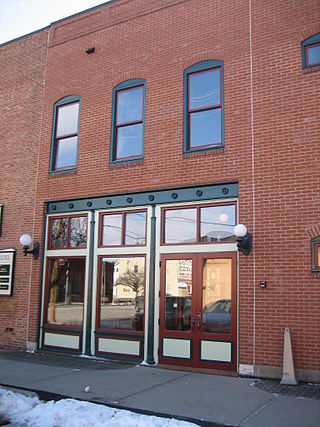
The building at 302 Washington St. in Oregon, Illinois is part of trio of historic Italianate commercial buildings within the boundaries of the Oregon Commercial Historic District from 300-306 Washington. The structure acts mostly as a hallway area between the buildings at 300 Washington St. and the F.G. Jones Block. The interior and exterior have been significantly restored on all three buildings. As part of the Commercial Historic District 300 Washington Street was added to the National Register of Historic Places in August 2006.

The Jefferson Intermediate School is a school building located at 938 Selden Street in Detroit, Michigan. It is also known as Jefferson Junior High School or Jefferson School. The school was listed on the National Register of Historic Places in 1997.

The Cass Park Historic District is a historic district in Midtown Detroit, Michigan, consisting of 25 buildings along the streets of Temple, Ledyard, and 2nd, surrounding Cass Park. It was listed on the National Register of Historic Places in 2005 and designated a city of Detroit historic district in 2016.

The Palmer Park Boulevard Apartments District is a collection of three apartment buildings located in Highland Park, Michigan. The district was listed on the National Register of Historic Places in 1992.

The Company F State Armory, also known as the Waltham State Armory, is a historic armory building at Curtis and Sharon Streets in Waltham, Massachusetts. Built in 1908, it is locally notable for its Georgian Revival architecture, and as the city's only armory building. It was among the last of the state's armories to be built to individualized architectural design. The building was listed on the National Register of Historic Places in 1989. The building is vacant.

Flanley's Block is a historic commercial building at 349–353 Main Street in Wakefield, Massachusetts, US. Built about 1895, it is a well-preserved local example of late 19th-century Italianate commercial architecture. The building was listed on the National Register of Historic Places in 1989.

The U.S. Post Office in Le Roy, New York, serves the 14482 ZIP Code, covering the village and town of Le Roy. It is a brick and stone building on Main Street erected in the late 1930s.

The U.S. Post Office in Granville, New York, United States, is located on Main Street in the center of the village. It is a brick building serving the ZIP Code 12832, which covers the village and surrounding areas of the Town of Granville.

105 South Washington Street in Huntsville, Alabama, is a historic commercial building. It was built in 1931, after the previous building on the site had burned in 1925. The street level of the two-story brick building has three single-pane windows on either side of a recessed entry. A row of similar windows runs above the street level, separated by a row of rectangular panels. Above the storefront level sits a panel of soldier course bricks, with decorative terra cotta floral blocks on the corners. The same blocks are used on the top corners of the surrounds for five windows above. The frieze is terra cotta, with a series of narrow flutes above a decorative bed-mould chain. The cornice features a geometric X-pattern with small dentils on each block. The terra cotta detailing exhibits Art Deco influence, popular at the time the building was constructed. The building was listed on the National Register of Historic Places in 1984.
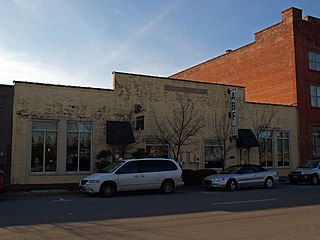
The Kelly Brothers and Rowe Building is a historic warehouse in Huntsville, Alabama. Built in 1928, the façade is nearly free of ornamentation, except for a raised central parapet, with a plaque reading "Kelly Bros. & Rowe", and soldier course brick outlining the building and openings. Originally, the front featured two large warehouse doors, each with an entry door and a multi-pane window towards the center of the building. The warehouse doors have each been replaced with a twin-pane fixed window and transom, and the multi-pane windows have been replaced with a single pane and transom.
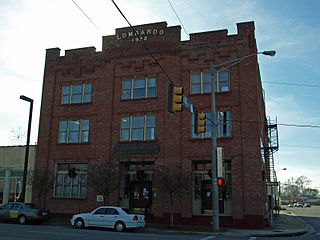
The Lombardo Building is a historic warehouse in Huntsville, Alabama. The three-story brick structure was built in 1922. The façade is divided into three bays by four piers. The center and right bays each have a double entry door with transom and sidelights, while the left bay contains a group of four one-over-one sash windows topped with a transom. Each of the upper floors has groups of three one-over-one windows. Each bay is topped with three decorative corbels, below a stepped parapet. The center of the parapet is marked with "LOMBARDO" and "1922".

The Donegan Block is a historic commercial building in Huntsville, Alabama. Built in 1870, it and the adjacent building, the Rand Building, represent a simplified Italianate architecture style common in smaller towns in the late 19th century. It is one of few remaining Italianate buildings which once were prevalent on Courthouse Square. The 2+1⁄2-story building is divided into four units, each three bays wide. The units are divided on the façade by brick pilasters, which were originally faced with cast iron on the ground floor. The two eastern units are combined, and share an entrance flanked by two multi-paned fixed windows on each side. The other two units have central entrances with one window on each side. The three eastern units are treated similarly, with triangular pediments and pilasters surrounding each door and window. The western unit had been modified with a recessed entry and windows, but these were later returned flush with the building and are topped with fanlights and segmental brick arches. Second floor windows on all four units are tall and narrow with arched tops and roll moldings with keystones. The attic level has short vents treated similarly to the second floor windows. A bracketed and denticulated metal cornice projects from the top of the building. It was listed on the National Register of Historic Places in 1980.
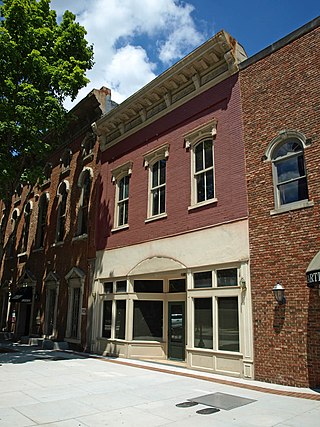
The Rand Building is a historic commercial building in Huntsville, Alabama. Built in 1883, it and the adjacent building, the Donegan Block, represent a simplified Italianate architecture style common in smaller towns in the late 19th century. It is one of few remaining Italianate buildings which once were prevalent on Courthouse Square. The two-story green-painted brick building has an elaborate bracketed metal cornice with decorative panels between the brackets. The street-level façade has large four-pane fixed windows supported by paneled bulkheads, with a central recessed entry. A second row of smaller windows runs above the first, below a smoothed concrete header panel which along which an awning runs the width of the building. On the second floor, three two-over-two sash windows with segmental arched tops are in a frame recessed one course from the rest of the building. It was listed on the National Register of Historic Places in 1980.

The Yarbrough Hotel is a historic building in Huntsville, Alabama. The four-story structure was built of brick and reinforced concrete in 1922–25. The top three floors contain 75 rooms, while the ground floor features the hotel lobby and storefronts; as it did not have a ballroom or party rooms, it catered to businessmen. It faced competition from the Twickenham Hotel one block away, and the Russel Erskine Hotel. Yarbrough operated as a residential hotel until the late 1950s, and was renovated in the 1980s.

The Struve–Hay Building is a historic commercial building in Huntsville, Alabama. Built in 1900, it represents a transition between Victorian architecture style and the less ornamented Commercial Brick style. The building was originally two stories with a three-story tower on the corner, but the second story of the Jefferson Street façade was removed in 1955. Previously consisting of two storefronts, the Jefferson Street side was later combined into one, with a recessed central entrance flanked by pilasters and two large single-pane fixed windows on either side. This portion of the building is also painted white with green accents, rather than the red with unpainted stone accents of the remainder of the building, providing additional visual separation. The corner and first bay of either side are adorned with stone pilasters with capitals supporting a stone course that wraps around the building. The tower has a single one-over-one sash window on each face of the second floor, with a pair of small arched windows on the third. It is topped with a pyramidal roof and ball finial. Along Holmes Avenue, the first floor has no windows, while the second floor has a pair of one-over-one windows per bay. The building is topped with a bracketed pressed metal cornice. The roof on the end of the building on the Holmes side steps down to a separate unit, featuring a Romanesque Revival arched entryway below a bay window. The building was listed on the National Register of Historic Places in 1980.

The Schiffman Building is a historic commercial building in Huntsville, Alabama. The main structure of the building was built in 1845. Originally, it was a three-bay brick building divided by large, flat pilasters. The southern bay, at the corner of East Side Square and Eustis Avenue, was remodeled in the Richardsonian Romanesque style in 1895. The other two bays were demolished in the 1970s. Future Speaker of the U.S. House William B. Bankhead used the building as an office while he was Huntsville's city attorney from 1898–1902; his daughter, actress Tallulah Bankhead, was born in the second floor apartment. Issac Schiffman, a businessman and banker, purchased the building in 1905 and it has remained in the family since.
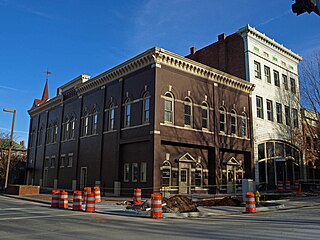
The Milligan Block is a historic commercial building in Huntsville, Alabama. It was built in 1900 and represents the transition from vertically-oriented Italianate style to more restrained, horizontally-oriented commercial styles of the early 20th century. It retains Italianate details such as an applied metal cornice and arched windows, but eschews other applied decoration in favor of using structural elements to provide ornamentation.

Starkweather School is an educational building located at 550 North Holbrook Street in Plymouth, Michigan. It was listed on the National Register of Historic Places in 2016. It is the only school from its time still extant in Plymouth, and the only school in Plymouth designed by Malcomson and Higginbotham, who designed numerous schools for the Detroit school district.

The Wallace Block is a commercial building located at 101-113 South Ann Arbor Street in Saline, Michigan. It was listed on the National Register of Historic Places in 1985.

Downtown Vermillion Historic District is a historic district in downtown Vermillion, South Dakota, consisting of 34 contributing buildings all constructed between 1880 and 1942. The district was added to the National Register of Historic Places in 2003 and reflects a period of substantial economic growth in Vermillion, as well as for its representation of late 19th and early 20th century architectural styles.

























